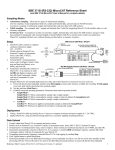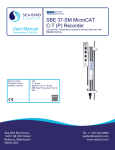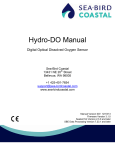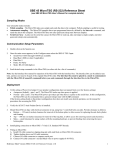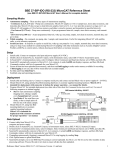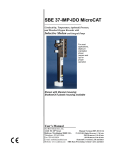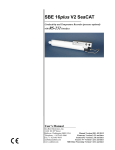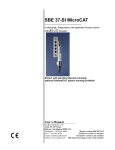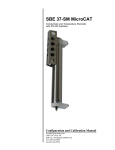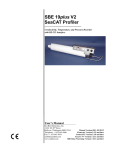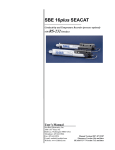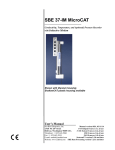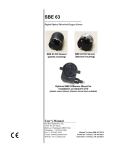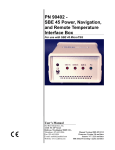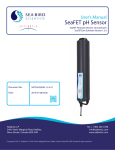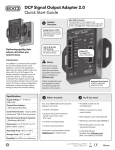Download RS-232 - Sea-Bird Electronics
Transcript
SBE 37-SMP-ODO (RS-232) MicroCAT Reference Sheet (see SBE 37-SMP-ODO MicroCAT User’s Manual for complete details) Sampling Modes • • • Autonomous sampling – At pre-programmed intervals, wake up, run pump, sample, store data in FLASH memory, and go to sleep. If desired, data can also be transmitted real-time. Polled sampling – On command, run pump, take one sample, and send data to computer. Polled sampling is useful for integrating MicroCAT with satellite, radio, or wire telemetry equipment. Serial line sync – In response to pulse on serial line, wake up, run pump, sample, store data in FLASH memory, and go to sleep. If desired, data can also be transmitted real-time. Easy method for synchronizing MicroCAT sampling with other instruments such as Acoustic Doppler Current Profilers (ADCPs) or current meters, without drawing on their battery or memory resources. Setup 1. 2. 3. 4. 5. 6. Install AA lithium cells (Note: ODO MicroCATs use a battery pack with a yellow cover plate): A. Remove connector end cap: Wipe dry housing/end cap seam. Remove 2 cap screws, twist end cap counterclockwise, and pull end cap out. Disconnect Molex connecting to battery pack. Wipe dry O-ring mating surfaces in housing with lint-free cloth. B. Remove battery pack and install cells: Loosen captured screw in battery pack cover. Use handle to lift pack out of housing. Keep handle upright. Unscrew cover plate. Roll 2 O-rings on side of pack out of grooves. Insert cells, and roll 2 O-rings back into grooves. Align pin on cover plate PCB with post hole, keep handle upright, and screw cover plate onto battery pack. C. Reinstall battery pack and connector end cap: Align D-shaped opening and pins on shaft. Lower battery pack into housing; push gently to mate. Tighten captured screw to secure battery pack in housing. Remove water from O-rings and mating surfaces with lint-free cloth. Inspect O-rings and mating surfaces for dirt, nicks, and cuts. Clean as necessary. Apply light coat of O-ring lubricant to O-ring and mating surfaces. Plug Molex connector together. Fit end cap into housing. Reinstall 2 cap screws. Install cable: Connect to computer serial port. Double click on SeatermV2.exe. SeatermV2 opens; in Instruments menu, select SBE 37 RS232. Seaterm232 opens. In Seaterm232’s Communications menu, select Configure. Select Comm port and baud rate (factory set to 9600), and click OK. Seaterm232 connects to MicroCAT and sends GetHD. Program MicroCAT for intended deployment (see other side of this sheet for Command Instructions and List): A. Ensure all data has been uploaded, and then send InitLogging to make entire memory available for recording. If InitLogging is not sent, data will be stored after last recorded sample. B. Set date and time (DateTime=), and establish logging parameters. C. Use one of following sequences to start logging: • StartNow to start logging now, sampling every SampleInterval= seconds. • StartDateTime= and StartLater to start logging at specified date and time, sampling every SampleInterval= seconds. • SyncMode=Y to place MicroCAT in serial line sync mode, so that a simple pulse on RS-232 line will initiate sample. Deployment 1. 2. Wiring – deploy with dummy plug or I/O cable (for external power and/or serial communication during deployment). Install locking sleeve. Mount MicroCAT with connector at bottom for proper operation – see manual for details. Data Upload 1. Connect cable from MicroCAT to computer. 2. Double click on SeatermV2.exe. SeatermV2 opens; in Instruments menu, select SBE 37 RS232. Seaterm232 opens. 3. In Seaterm232’s Communications menu, select Configure. Select Comm port and baud rate (factory set to 9600), and click OK. 4. Seaterm232 connects to MicroCAT and sends GetHD. 5. If sampling autonomously (logging), command MicroCAT to stop logging by sending Stop. 6. If desired, reset baud to increase upload speed (BaudRate=). After first entry, MicroCAT changes to new baud, then waits for command to be sent again at new baud (In Seaterm232’s Communications menu, select Configure. In dialog box, select new baud and click OK. Then retype command.). If it does not receive command again at new baud, it reverts to previous baud. 7. Click Upload menu to upload stored data. 8. Seaterm232 prompts you to run SBE Data Processing to convert uploaded .hex file to .cnv file for use by other modules in data processing software. Process file and review data to ensure all data has been uploaded. Reference Sheet Version #005, 03-11-14; Firmware Version 2.4.2 and later 1 Command Instructions and List • Input commands in upper or lower case letters and register commands by pressing Enter key. • If in quiescent (sleep) state, re-establish communications by clicking Connect in Communications menu or pressing Enter key. • If a new command is not received within 2 minutes after completion of a command, MicroCAT returns to quiescent (sleep) state. • MicroCAT sends an error message if invalid command is entered. Shown below are commands used most commonly in the field. See the Manual for complete listing and detailed descriptions. Category Command Description Get and display configuration data. GetCD Get and display status data. GetSD Get and display calibration coefficients. GetCC Get and display event counter data. GetEC Reset event counter. Status ResetEC Get and display hardware data. GetHD Display list of currently available commands. Help Get and display status. DS Get and display calibration coefficients. DC x= mmddyyyyhhmmss (real-time clock month, day, year, hour, minute, second). DateTime=x x= baud rate (4800, 9600, 19200, 38400, 57600, or 115200). Default 9600. BaudRate=x OutputExecutedTag=x x=Y: Output XML Executed and Executing tags. x=N: Do not. General x=Y: Output real-time data while sampling in autonomous or serial line sync mode x=N: Do not. Setup TxRealTime=x ReferencePressure=x x = reference pressure (dbar) (used when MicroCAT has no pressure sensor). Place MicroCAT in quiescent (sleep) state. Logging and memory retention not affected. QS x= minimum conductivity frequency (Hz) to enable pump turn-on. MinCondFreq= x=N: Run pump for [OxNTau * OxTau20] before each sample. AdaptivePumpControl=x x=Y: Use Adaptive Pump Control. Pump x= pump time multiplier. Range 1 – 100; default 7. OxNTau=x Setup Turn pump on, for testing. PumpOn Turn pump off, if turned on with PumpOn. PumpOff Send command to SBE 63 DO sensor and receive response. See SBE 63 manual for list. Following DO Sensor Send63=command SBE 63 setup required: SetEcho=1, SetFormat=1, SetAvg=1 to 16 (recommended value 2), SetAutoRun=0. Setup Initialize logging to make entire memory available for recording. InitLogging Memory Setup x= sample number for last sample in memory. SampleNumber=0 equivalent to InitLogging. SampleNumber=x x=0: Output raw decimal data. x=2: Output converted decimal data, XML. OutputFormat=x x=1 (default): Output converted decimal data. x=Y: Output temperature (units defined by SetTempUnits=). x=N: Do not. OutputTemp=x x=Y: Output conductivity (units defined by SetCondUnits=). x=N: Do not. OutputCond=x x=Y: Output pressure (units defined by SetPressUnits=). x=N: Do not. OutputPress=x x=Y: Output oxygen (units defined by SetOxUnits=). x=N: Do not. OutputOx=x Output x=Y: Output salinity (psu). x=N: Do not. OutputSal=x Format x=Y: Output sound velocity (m/sec). x=N: Do not. OutputSV=x Setup x=Y: Output specific conductivity (units defined by SetCondUnits=). x=N: Do not. OutputSC=x x=0: Use SetSCA=. x=1: Use default (0.020) thermal coefficient (specific conductivity calculation). UseSCDefault=x Only applicable if UseSCDefault=0. x= thermal coefficient (specific conductivity calculation). SetSCA=x x=Y: Output sample number with each polled sample. x=N: Do not. TxSampleNum=x x=0: Enable T, C, P, DO (°C, S/m, dbar, ml/L). x=1: Enable T, P, DO, SC (°C, psi, mg/L, µS/cm). SetCoastal=x x=0: Allow all commands. x=1: Enable T, C, P, DO (°C, S/m, dbar, ml/L); match firmware < 2.0. Legacy=x x = interval between samples (10 - 21600 sec). SampleInterval=x Start logging now. StartNow Autonomous Sampling x= mmddyyyyhhmmss (delayed logging start: month, day, year, hour, minute, second) StartDateTime=x (Logging) Start logging at delayed start time. StartLater Stop logging or waiting to start logging. Press Enter before sending Stop. Send before uploading data. Stop Do not pump. Take sample, store data in buffer, output data. TS Do not pump. Take sample, store data in buffer, output data in raw decimal format. TSR Run pump, take sample, store data in buffer, output data. TPS Run pump, take sample, store data in buffer, do not output data. TPSH Run pump, take sample, store data in buffer and in FLASH memory, output data. TPSS Polled Sampling Do not pump. Take x samples, output data. TSN:x Run pump continuously while taking x samples and outputting data. TPSN:x Do not pump. Take sample from SBE 63, output oxygen data in format set by SetFormat= in SBE 63. T63 Output last sample stored in buffer. SL Output last sample stored in buffer, then run pump, take new sample, and store data in buffer. SLTP x=Y: Enable serial line sync mode. x=N: Disable serial line sync mode. Sync Mode SyncMode=x Upload scan b to e; format defined by OutputFormat=. Send Stop before sending. GetSamples:b,e Data Upload Upload scan b to e; converted decimal form (OutputFormat=1). Send Stop before sending. DDb,e Calibration See manual. Coefficients Reference Sheet Version #005, 03-11-14; Firmware Version 2.4.2 and later 2



